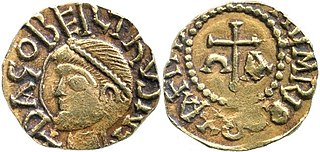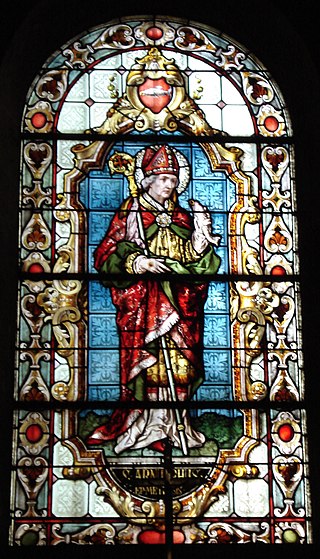The Battle of Tertry was an important engagement in Merovingian Gaul between the forces of Austrasia under Pepin II on one side and those of Neustria and Burgundy on the other. It took place in 687 at Tertry, Somme, and the battle is presented as an heroic account in the Annales mettenses priores. After achieving victory on the battlefield at Tertry, the Austrasians dictated the political future of the Neustrians.
The powerful Austrasian mayor of the palace, Pepin II had concluded peace with his Neustrian counterpart, Waratton, in 681. However, Waratton's successors had renewed the conflict between Austrasia and Neustria, which was common in times of disunion. The Frankish realm was then united under King Theuderic III, who inherited Austrasia in 679. Theuderic III—born and raised in Neustria and a Neustrian at heart—and the nobles of Neustria and Burgundy, under their mayor, Berchar, invaded Austrasia territory. Berchar and Theuderic were routed at Tertry by Pepin in 687 and the Austrasians held the field. Historian Michael Frassetto avows that the war during which the battle of Tertry occurred was essentially the result of a long-standing feud between Austrasian and Neustrian leaders and the civil strife within Neustria itself. According to the text of the Annales mettenses priores—likely written at the Chelles monastery—Pepin II had led the Austrasians to a magnificent victory during the battle of Tertry.
Their supremacy vindicated on a battlefield, the victors forced Berchar out of office and Pepin appointed Nordebert to act on his behalf in Neustria. The king was forced to recognise Pepin's mayorship over Austrasia, Neustria and Burgundy. Eclipsing the Neustrian Mayors, Pepin's victory brought about the effective end of the old seat of Merovingian power, enabling the Arnulfing Mayors to control Neustrian political developments. According to historian Rosamond McKitterick, the Battle of Tertry constitutes one of the decisive moments for the Carolingian house and its history. Despite the importance of Tertry in strengthening Pepin's position, it was another two generations before Pepin the Short claimed the kingship of the Franks.
The legacy of the battle was the further diminution of royal authority; the supremacy of Austrasia over the rest of the realm, characterised by later conquests to the east and the Aachen-centred Carolingian Empire; the undisputed right to rule of the Arnulfing clan, Pepin even taking the title of dux et princeps Francorum ; and, finally, the personal gains to Pepin, who "reigned", as one chronicle put it, thereafter over all the Franks for 27 more years. Pepin spent the remainder of the seventh century and the early years of the eighth-century reestablishing Frankish supremacy in Germany, during which time he forced the Frisians, Saxons, Alemanni, Suebians, Thuringians, and Bavari peoples to acknowledge their subordination to the Franks.
From the battle of Tertry forward, a mayor from Pepin's clan remained the senior figure within Francia. Under Pepin's heir — his illegitimate son Charles Martel — the Franks would achieve their most important victory in checking the Muslim advance into central Europe. Martel's rule also delineates the beginning of Carolingian power.
Pepin II, commonly known as Pepin of Herstal, was a Frankish statesman and military leader who de facto ruled Francia as the Mayor of the Palace from 680 until his death. He took the title Duke and Prince of the Franks upon his conquest of all the Frankish realms.

Austrasia was a territory which formed the north-eastern section of the Kingdom of the Franks from the 6th to 8th centuries, ruled by the Frankish Merovingian and Carolingian dynasties during the Early Middle Ages. It was centred on the Meuse, Middle Rhine, and the Moselle rivers, and was the original territory of the Franks, including both the so-called Salians and Rhineland Franks, which Clovis I, King of the Franks (481–511) conquered after first taking control of the bordering part of Roman Gaul, which is sometimes described in this period as Neustria.

Dagobert I was King of the Franks. He ruled Austrasia (623–634) and Neustria and Burgundy (629–639). He has been described as the last king of the Merovingian dynasty to wield real royal power. Dagobert was the first Frankish king to be buried in the royal tombs at the Basilica of Saint-Denis.

Chlothar II, sometime called "the Young", was king of the Franks, ruling Neustria (584-629), Burgundy (613-629) and Austrasia (613-623).

Neustria was the western part of the Kingdom of the Franks during the early middle ages, in contrast to the eastern Frankish kingdom, Austrasia. It initially included land between the Loire and the Silva Carbonaria, in the north of present-day France, with Paris, Orléans, Tours, Soissons as its main cities. The population was therefore originally largely Romanised.

The Carolingian dynasty was a Frankish noble family named after Charlemagne, grandson of mayor Charles Martel and a descendant of the Arnulfing and Pippinid clans of the 7th century AD. The dynasty consolidated its power in the 8th century, eventually making the offices of mayor of the palace and dux et princeps Francorum hereditary, and becoming the de facto rulers of the Franks as the real powers behind the Merovingian throne. In 751 the Merovingian dynasty which had ruled the Germanic Franks was overthrown with the consent of the Papacy and the aristocracy, and Pepin the Short, son of Martel, was crowned King of the Franks. The Carolingian dynasty reached its peak in 800 with the crowning of Charlemagne as the first Emperor of the Romans in the West in over three centuries. His death in 814 began an extended period of fragmentation of the Carolingian Empire and decline that would eventually lead to the evolution of the Kingdom of France and the Holy Roman Empire.

Childeric III was King of the Franks from 743 until he was deposed in 751 by Pepin the Younger. He was the last Frankish king from the Merovingian dynasty. Once Childeric was deposed, Pepin became king, initiating the Carolingian dynasty.

Ebroin was the Frankish mayor of the palace of Neustria on two occasions; firstly from 658 to his deposition in 673 and secondly from 675 to his death in 680 or 681. In a violent and despotic career, he strove to impose the authority of Neustria, which was under his control, over Burgundy and Austrasia.

Arnulf of Metz was a Frankish bishop of Metz and advisor to the Merovingian court of Austrasia. He later retired to the Abbey of Remiremont. In French he is also known as Arnoul or Arnoulf. In English he is known as Arnold.

The Kingdom of the Franks, also known as the Frankish Kingdom, the Frankish Empire or Francia, was the largest post-Roman barbarian kingdom in Western Europe. It was ruled by the Frankish Merovingian and Carolingian dynasties during the Early Middle Ages. Francia was among the last surviving Germanic kingdoms from the Migration Period era.

Theuderic III was King of the Franks. He ruled Neustria and Burgundy on two occasions as well as Austrasia from 679 to his death in 691.
The Pippinids and the Arnulfings were two Frankish aristocratic families from Austrasia during the Merovingian period. They dominated the office of mayor of the palace after 687 and eventually supplanted the Merovingians as kings in 751, founding the Carolingian dynasty.
Liber Historiae Francorum is a chronicle written anonymously during the 8th century. The first sections served as a secondary source for early Franks in the time of Marcomer, giving a short breviarum of events until the time of the late Merovingians. The subsequent sections of the chronicle are important primary sources for the contemporaneous history. They provide an account of the Pippinid family in Austrasia before they became the most famous Carolingians.
Drogo was a Frankish nobleman, the eldest son of Pippin of Heristal and Plectrudis. He was the duke of Champagne from the early 690s.
Wulfoald was the mayor of the palace of Austrasia from 656 or 661 to his death, as well as mayor of the palace of Neustria and Burgundy from 673 to 675.
Ragenfrid was the mayor of the palace of Neustria and Burgundy from 715, when he filled the vacuum in Neustria caused by the death of Pepin of Heristal, until 718, when Charles Martel finally established himself over the whole Frankish kingdom.
The Annals of Metz are a set of Latin Carolingian annals covering the period of Frankish history from the victory of Pepin II in the Battle of Tertry (687) to the time of writing. Although the annals do cover events following 806, these sections are not original writings but are additions borrowed from other texts and appended to the original annals in the 9th and 12th centuries.

The Battle of Lucofao was the decisive engagement of the civil war that afflicted the Frankish kingdoms during and after the reign of Dagobert II (676–79). In the battle, the Neustrian forces of Theuderic III and his majordomo Ebroin defeated the forces of Austrasia under the dukes Pippin and Martin.
Anstrud was a medieval Frankish noblewoman of the late Merovingian/early Carolingian period. Anstrud was the daughter of Waratto, Mayor of the Palace of Neustria and Burgundy, and Ansflede.











